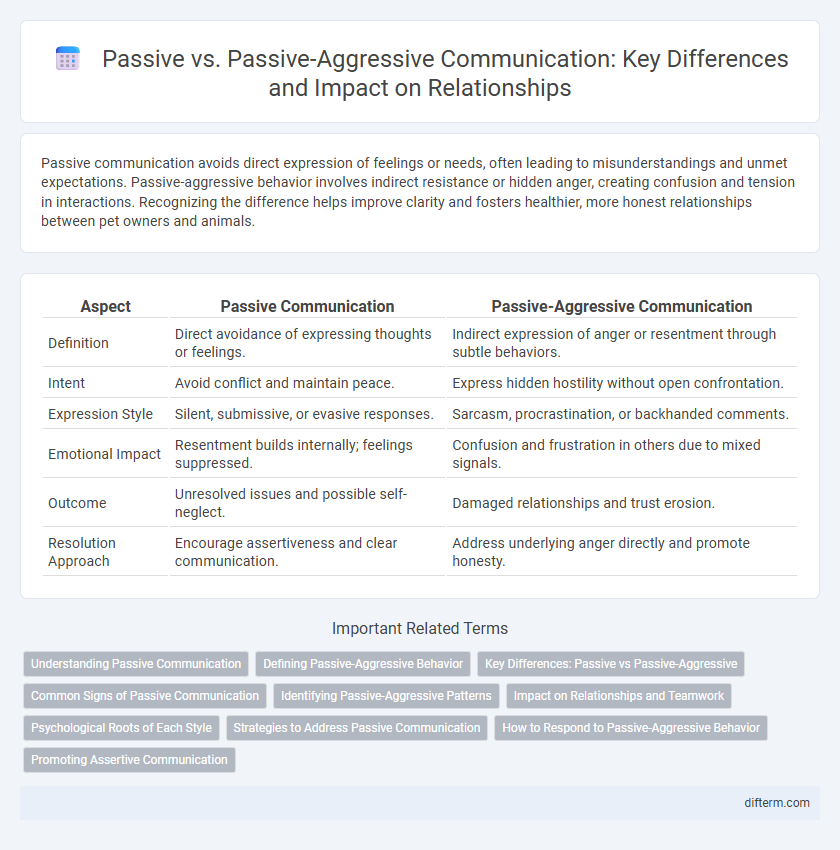Passive communication avoids direct expression of feelings or needs, often leading to misunderstandings and unmet expectations. Passive-aggressive behavior involves indirect resistance or hidden anger, creating confusion and tension in interactions. Recognizing the difference helps improve clarity and fosters healthier, more honest relationships between pet owners and animals.
Table of Comparison
| Aspect | Passive Communication | Passive-Aggressive Communication |
|---|---|---|
| Definition | Direct avoidance of expressing thoughts or feelings. | Indirect expression of anger or resentment through subtle behaviors. |
| Intent | Avoid conflict and maintain peace. | Express hidden hostility without open confrontation. |
| Expression Style | Silent, submissive, or evasive responses. | Sarcasm, procrastination, or backhanded comments. |
| Emotional Impact | Resentment builds internally; feelings suppressed. | Confusion and frustration in others due to mixed signals. |
| Outcome | Unresolved issues and possible self-neglect. | Damaged relationships and trust erosion. |
| Resolution Approach | Encourage assertiveness and clear communication. | Address underlying anger directly and promote honesty. |
Understanding Passive Communication
Passive communication involves avoiding direct expression of thoughts and feelings, often to prevent conflict or rejection. Individuals employing passive communication may exhibit behaviors such as hesitation, apology, and difficulty asserting themselves, leading to misunderstandings and unmet needs. Recognizing these patterns is essential to foster clearer, more effective interactions and to differentiate passive communication from passive-aggressive behavior, which harbors concealed resentment.
Defining Passive-Aggressive Behavior
Passive-aggressive behavior involves indirect resistance to demands or requests, often expressed through procrastination, stubbornness, or intentional inefficiency, contrasting with passive communication which typically lacks direct confrontation or expression of feelings. This behavior complicates interpersonal communication by masking true emotions behind seemingly compliant actions, leading to misunderstandings and unresolved conflicts. Recognizing passive-aggressive patterns is essential for improving clarity and fostering healthier, more assertive communication in personal and professional relationships.
Key Differences: Passive vs Passive-Aggressive
Passive communication involves avoiding direct expression of thoughts and feelings to prevent conflict, often resulting in suppressed emotions and unassertiveness. Passive-aggressive communication disguises negative feelings through indirect behaviors, such as sarcasm, procrastination, or subtle sabotage, masking true emotions behind seemingly compliant actions. The key difference lies in the expression method: passive communication hides emotions through silence or withdrawal, whereas passive-aggressive communication expresses negativity through indirect resistance or covert hostility.
Common Signs of Passive Communication
Common signs of passive communication include avoiding eye contact, speaking softly or hesitantly, and failing to express personal opinions or needs clearly. Individuals often apologize excessively and exhibit nonverbal cues such as slumped posture or nervous gestures. This communication style prioritizes others' comfort over self-expression, leading to suppressed feelings and unmet needs.
Identifying Passive-Aggressive Patterns
Passive-aggressive communication often involves indirect expressions of hostility, such as sarcasm, procrastination, or deliberate inefficiency, which contrast with straightforward passive behavior characterized by withdrawal or silence. Key indicators include inconsistent verbal messages paired with negative nonverbal cues like eye-rolling or sighing, creating confusion in interpersonal interactions. Recognizing these patterns is essential for addressing underlying conflicts and fostering more honest and effective dialogue.
Impact on Relationships and Teamwork
Passive communication often leads to misunderstandings and unresolved conflicts, weakening trust within teams. Passive-aggressive behavior creates confusion and resentment, disrupting collaboration and lowering overall morale. Clear, direct communication fosters stronger relationships and more effective teamwork by promoting transparency and mutual respect.
Psychological Roots of Each Style
Passive communication stems from fear of confrontation and low self-esteem, where individuals suppress their true feelings to avoid conflict. Passive-aggressive behavior originates from unresolved anger and indirect expression of hostility, often as a defense mechanism to gain control without open confrontation. Understanding these psychological roots helps in identifying and addressing communication barriers for healthier interactions.
Strategies to Address Passive Communication
Identifying passive communication involves recognizing indirect expressions of needs or feelings, often marked by hesitation or avoidance of confrontation. Strategies to address passive communication include encouraging assertiveness through clear, direct expression of thoughts and emotions while maintaining respect for others. Implementing active listening and providing constructive feedback can help individuals build confidence in expressing themselves openly and effectively.
How to Respond to Passive-Aggressive Behavior
Responding effectively to passive-aggressive behavior requires clear, assertive communication that addresses the underlying emotions without escalating conflict. Using "I" statements helps express feelings directly while encouraging openness and reducing defensiveness. Maintaining calm and setting boundaries promotes healthier dialogue and prevents passive-aggressive patterns from persisting.
Promoting Assertive Communication
Passive communication often involves avoiding confrontation and suppressing one's own needs, which can lead to misunderstandings and unmet expectations. Passive-aggressive communication disguises hostility through indirect behaviors such as sarcasm or procrastination, undermining trust and collaboration. Promoting assertive communication encourages clear, honest expression of thoughts and feelings while respecting others, fostering mutual understanding and effective conflict resolution.
Passive vs Passive-Aggressive Infographic

 difterm.com
difterm.com